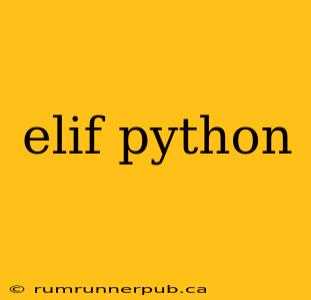Python's elif statement is a crucial tool for building sophisticated conditional logic within your programs. It allows you to check multiple conditions sequentially, executing only the block of code associated with the first condition that evaluates to True. This article delves into the mechanics of elif, offering practical examples and insights drawn from Stack Overflow discussions to solidify your understanding.
Understanding the elif Structure
The basic syntax is straightforward:
if condition1:
# Code to execute if condition1 is True
elif condition2:
# Code to execute if condition1 is False and condition2 is True
elif condition3:
# Code to execute if condition1 and condition2 are False, and condition3 is True
else:
# Code to execute if none of the above conditions are True
Crucially, the elif blocks are only checked if the preceding if and any previous elif conditions are False. This sequential evaluation is key to its functionality.
Illustrative Examples
Let's explore some practical scenarios, drawing inspiration from real-world Stack Overflow questions.
Example 1: Grading System (Inspired by Stack Overflow discussions on conditional logic)
Many Stack Overflow users seek assistance crafting grading systems. Here's a solution utilizing elif:
score = 85
if score >= 90:
grade = "A"
elif score >= 80:
grade = "B"
elif score >= 70:
grade = "C"
elif score >= 60:
grade = "D"
else:
grade = "F"
print(f"Your grade is: {grade}")
This code efficiently assigns letter grades based on the numerical score. Note how the conditions are ordered from highest to lowest score, ensuring correct grade assignment. This is a common pattern when using elif for ranges.
Example 2: Handling User Input (Addressing common Stack Overflow input validation issues)
Validating user input is critical. elif can help handle different input types gracefully:
user_input = input("Enter a number: ")
try:
number = float(user_input)
if number > 0:
print("Positive number")
elif number < 0:
print("Negative number")
else:
print("Zero")
except ValueError:
print("Invalid input. Please enter a number.")
This example first attempts to convert the user input to a float. If successful, it uses elif to determine the number's sign. The try-except block handles potential ValueError exceptions if the user enters non-numeric data, a common problem addressed on Stack Overflow.
elif vs. Nested if Statements
While you can achieve the same results with nested if statements, elif often provides a cleaner and more readable solution, especially when dealing with multiple conditions. Nested ifs can become deeply indented and harder to follow. elif maintains a flatter structure, improving code readability.
Example demonstrating the difference:
Using elif (preferred):
if x > 5:
print("x is greater than 5")
elif x == 5:
print("x is equal to 5")
else:
print("x is less than 5")
Using nested if (less readable):
if x > 5:
print("x is greater than 5")
else:
if x == 5:
print("x is equal to 5")
else:
print("x is less than 5")
The elif version is clearly more concise and easier to understand.
Conclusion
Python's elif statement is a powerful construct that significantly enhances your ability to create robust and readable conditional logic. By understanding its sequential evaluation and using it effectively, you can write more efficient and maintainable Python code. Remember to structure your conditions logically and consider readability when choosing between elif and nested if statements. This article, informed by common Stack Overflow questions and best practices, equips you to confidently utilize elif in your future programming endeavors.
